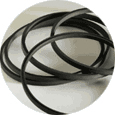
Not all seals are the same. In addition to standard O-rings, there are spring-energized seals. Spring-energized seals feature the same ring-shaped design as their O-ring counterparts, but they are comprised of two parts: a jacket and spring.
Spring-energized seals work like a spring. When exposed to a force, they still store mechanical energy. Spring-energized seals use this mechanical energy to protect the parts with which they are used from leaking. There are different types of spring-energized seals, but they all have a jacket and spring.
#1) The Jacket
The jacket is the outer part of a spring-energized seal. It’s typically made of a strong, corrosion-resistant material, such as polytetrafluoroethylene (PTFE). Regardless, all spring-energized seals have a jacket. The jacket is simply the outer part.
Spring-energized seals are commonly used as an alternative to traditional elastomeric seals. Elastomeric seals, of course, are characterized by an elastomeric construction. They are made of an elastic material, such as rubber. Spring-energized seals are made of different materials. They feature a jacket and a spring, which allow for better protection against leaks in extreme environments.
#2) The Spring
The spring, on the other hand, is the inner part of a spring-energized seal. The jacket wraps around the spring. When combined, these two parts form a spring-energized seal.
The spring is responsible for storing mechanical energy. Spring-energized seals are used for the same purpose of sealing mating surfaces as most other seals. They are known as “spring-energized seals,” however, because they store mechanical energy like conventional springs. As the fluid flowing through it heats up or otherwise pressurizes, the spring-energized seal will store its mechanical energy.
The seal part of the spring-energized seal is used for this purpose. It’s made of a synthetic material that’s able to store mechanical energy. The spring will typically deform when exposed to pressure. As the spring deforms, it will expand while simultaneously pressing against the shaft lip and the jacket.
If you’ve already tried conventional seals, such as elastomeric seals, and are still experiencing leaks, you may want to try a spring-energized seal. They offer greater protection against leaks thanks to their two-part design. Spring-energized seals have a jacket and a lip. With these two parts, they can withstand heat, corrosive chemicals and other extreme environmental elements without failing.
In Conclusion
Spring-energized seals feature a jacket and spring. The jacket is the outer part, whereas the spring is the inner part.
